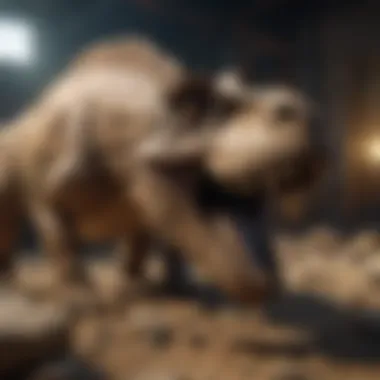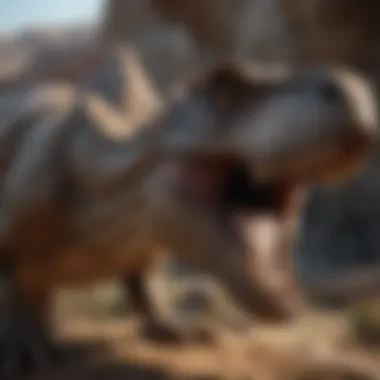Unveiling the Magnificent Past: Unearthing a Dinosaur Fossil


Rock and Fossil Identification
Unearthing the majestic past begins with understanding the intricate world of rock and fossil identification. As paleontologists delve into the earth's layers, they encounter various types of rocks and fossils, each holding clues to the distant past. Fossils are remnants of ancient organisms preserved in rock, ranging from imprints and traces to full skeletal remains. To identify these specimens, scientists look for specific characteristics such as color, texture, and composition, using tools like magnifying glasses, chisels, and brushes to carefully reveal the fossil's details.
Collecting Tips and Techniques
For aspiring fossil hunters, mastering the art of collecting is essential to unearth the treasures hidden beneath the surface. Adopting best practices involves thorough research to locate prime collecting sites where fossils are likely to be found. Once a promising site is identified, it's crucial to approach specimen extraction with caution and precision to avoid damage. Safely extracting fossils requires tools like rock hammers, shovels, and plaster to support delicate finds during transportation.
Preservation and Display
After the excitement of discovery comes the vital task of preserving and showcasing fossils for future generations to admire. Preserving fossils involves using techniques like molding, casting, and stabilizing fragile specimens to prevent deterioration. Proper storage is key to maintaining the fossil's integrity, with methods including climate-controlled environments and archival materials to ensure long-term preservation. Furthermore, creative display ideas add an artistic touch, enhancing the aesthetic appeal of the fossils while showcasing their scientific value.
Geological Insights
Delving deeper into the world of paleontology unveils fascinating geological insights that provide context to ancient life forms. By studying geological formations and processes, scientists unravel the environmental conditions that shaped Earth's history, shedding light on the processes that led to fossilization. Exploring the historical significance of rocks and fossils showcases their invaluable contribution to understanding evolution and Earth's natural history. Notable discoveries in the field offer a glimpse into groundbreaking research that continues to expand our knowledge of the prehistoric world.
Introduction
In the realm of paleontology, the unearthing of a dinosaur fossil represents a pivotal moment that allows us to peel back the layers of time and delve into the majestic past that once ruled the Earth. This article serves as a beacon of knowledge, shedding light on the enigmatic world of prehistoric creatures and the intricate processes involved in studying their fossilized remains. By meticulously excavating and analyzing these ancient relics, scientists open a window to a bygone era, offering a tantalizing glimpse into the lives of creatures that roamed Earth millions of years ago.
Exploring the Depths of History
Significance of Dinosaur Fossils
The significance of dinosaur fossils lies not only in their intrinsic value as remnants of extinct creatures but also in the wealth of information they provide about our planet's past. These fossils serve as time capsules, preserving valuable data regarding ancient ecosystems, evolutionary processes, and the diversity of life forms that once existed. Their study is instrumental in shaping our understanding of Earth's history, unraveling mysteries that have captured the imagination of scientists and enthusiasts alike. The meticulous analysis of dinosaur fossils offers a unique opportunity to connect with a distant past, enriching our knowledge of prehistoric life and the forces that have shaped our world today.
Unveiling Ancient Mysteries
The process of unveiling ancient mysteries through the study of dinosaur fossils is a multifaceted endeavor that intertwines science, history, and detective work. Each fossil holds clues to a bygone world, where creatures of immense size and complexity roamed landscapes vastly different from our own. By piecing together these clues, scientists can reconstruct long-lost ecosystems, speculate on the behavior of ancient species, and contemplate the forces that led to their eventual extinction. Unveiling ancient mysteries not only tantalizes our curiosity but also offers a profound insight into the wonders of evolutionary history, painting a vivid picture of a world long past.
Discovery of the Fossil
Excavation Process


The excavation process involved in unearthing a dinosaur fossil is a delicate dance between preserving the integrity of the specimen and extracting it from its rocky tomb. From the painstaking removal of surrounding sediments to the meticulous documentation of each find, every step in the excavation process is guided by a commitment to accuracy and detail. Paleo continues
Initial Observations
Initial observations of a newly discovered dinosaur fossil provide researchers with crucial insights into the specimen's condition, preservation, and potential significance. By carefully examining the external features of the fossil, scientists can make preliminary assessments regarding its species, age, and taphonomic history. These initial observations shape the trajectory of further analyses, guiding researchers towards the most pertinent areas of study and inquiry. The process of making initial observations is a gateway to unlocking the mysteries held within a fossilized relic, setting the stage for in-depth investigations that promise to reveal the secrets of a distant past.
Analyzing the Findings
In this article, the section of Analyzing the Findings plays a pivotal role in uncovering the intricate details of the unearthed dinosaur fossil. Delving deep into the analysis stage, scientists are able to extract valuable insights that shed light on the history and characteristics of this ancient creature. By focusing on the specific elements of the findings, this section provides a detailed examination of the fossil's composition, age, and other significant aspects. Throughout the meticulous analysis process, scientists aim to piece together a comprehensive understanding of the dinosaur fossil's significance in the broader field of paleontology.
Paleontological Examination
Study of Bone Structure
The Study of Bone Structure holds paramount importance in the field of paleontology and specifically in the context of analyzing the fossil of a dinosaur. This aspect involves scrutinizing the morphology, density, and composition of the fossilized bones to glean insights into the anatomy and physiology of the ancient creature. By examining the intricate details of the bone structure, researchers can discern crucial information about the dinosaur's skeletal system, movement patterns, and evolutionary adaptations. The Study of Bone Structure serves as a fundamental pillar in deciphering the identity and behavior of the fossilized specimen, offering valuable clues to its life history.
Moreover, the meticulous analysis of bone structure enables scientists to distinguish between different species of dinosaurs and even identify unique features characteristic of a specific genus or era. This detailed examination not only contributes to the overall understanding of the fossil but also helps in reconstructing a visual representation of the dinosaur, bringing it closer to life for enthusiasts and researchers alike.
Identification of Species
In the investigation of the dinosaur fossil, the Identification of Species stands as a crucial aspect that aids in categorizing and cataloging the ancient creature within the scientific realm. By carefully studying the anatomical features, size, and skeletal characteristics of the fossil, scientists can determine the species to which it belonged with a reasonable degree of accuracy. This process involves comparing the fossilized remains to existing data on known dinosaur species, employing comparative anatomy and taxonomic principles to reach a conclusive identification.
The Identification of Species not only provides valuable information regarding the specific classification of the dinosaur but also offers insights into its evolutionary lineage, ecological niche, and potential interactions with other species. Understanding the identified species enhances our knowledge of prehistoric biodiversity and evolutionary patterns, contributing significantly to the scientific narrative surrounding the fossil discovery.
Scientific Techniques Used
Radiometric Dating
The application of Radiometric Dating in the analysis of the dinosaur fossil plays a pivotal role in determining its age and establishing a chronological framework for its existence. This technique relies on the decay rates of radioactive isotopes present in the fossilized remains to calculate the time elapsed since the creature's demise. By measuring the ratios of isotopes such as carbon-14 or uranium-lead within the fossils, scientists can ascertain the absolute age of the specimen with a high degree of precision.
Radiometric Dating offers a valuable tool in paleontological research, allowing researchers to establish temporal sequences of fossil deposits, identify geological ages, and correlate findings across different dig sites. This technique provides a fundamental basis for understanding the evolutionary timeline of dinosaurs and placing their existence within the broader context of Earth's history.
Isotope Analysis


Complementing the insights obtained from radiometric dating, Isotope Analysis serves as a sophisticated scientific technique that provides additional layers of information about the dinosaur fossil. This method involves examining the stable isotopes present in the fossilized tissues to infer dietary habits, environmental conditions, and migration patterns of the ancient creature. By analyzing the isotopic signatures within the fossil, scientists can reconstruct aspects of the dinosaur's paleoecology and gain insights into its habitat preferences.
Isotope Analysis enables researchers to unravel the complex interactions between dinosaurs and their ecosystems, shedding light on how environmental factors influenced their behavior, migration routes, and population dynamics. The integration of isotope data enhances the multidimensional view of the dinosaur fossil, offering a more comprehensive understanding of its life history and ecological adaptations.
Interpretation and Implications
In the context of this article, "Interpretation and Implications" hold a significant role in unraveling the mysteries of the prehistoric world encapsulated within the discovery of the dinosaur fossil. Through a meticulous examination of the find, scientists can piece together vital information that sheds light on various aspects of ancient life on Earth. The interpretation of the fossil's structure, composition, and surrounding environment allows researchers to reconstruct the past with a high degree of accuracy.
When delving into the implications, one cannot overlook the invaluable insights that this discovery provides to the scientific community and the general public. By piecing together the puzzle of the dinosaur fossil, researchers can draw connections to evolutionary patterns, habitat preferences, and behavioral traits of ancient creatures. This in-depth analysis not only adds to our understanding of prehistoric life but also contributes to advancements in paleontological research and evolutionary studies.
Reconstructing the Past
Life of Dinosaurs
Exploring the "Life of Dinosaurs" delves into the intricate details of how these majestic creatures lived, evolved, and interacted within their ecosystems. This specific aspect encapsulates the various species, sizes, diets, and adaptations that made dinosaurs such fascinating beings. The detailed examination of dinosaur life offers a window into understanding their evolutionary paths, survival strategies, and unique characteristics that set them apart from other organisms.
Among the key characteristics of dinosaur life highlighted in this article is the remarkable diversity present among different species, showcasing the evolutionary success and endurance of these creatures over millions of years. The popular choice of focusing on dinosaur life stems from its widespread appeal to researchers, educators, and the general public due to the awe-inspiring nature of these ancient behemoths.
The unique feature of exploring dinosaur life lies in its ability to provide a glimpse into a world long gone, offering insights into how environmental changes, competition, and adaptation shaped the evolution of these extraordinary creatures. While the advantages of studying dinosaur life are plentiful, one potential disadvantage could be the challenge of extrapolating behavior and interactions from fossil evidence alone.
Habitat and Behavior
Analyzing the "Habitat and Behavior" of dinosaurs elucidates critical information about their preferred environments, movement patterns, social structures, and feeding habits. This aspect contributes immensely to understanding the ecological dynamics of prehistoric landscapes and how dinosaurs thrived in diverse habitats across the globe. By examining fossil records, trackways, and coprolites, researchers can piece together a comprehensive picture of dinosaur behaviors.
The key characteristic of habitat and behavior lies in its ability to provide clues about how dinosaurs adapted to changing climates, food availability, and interactions with other species. This aspect is a beneficial choice for this article as it allows readers to connect with the ancient world on a more personal level, bridging the gap between scientific analysis and everyday curiosity about dinosaur lives.
The unique feature of exploring habitat and behavior revolves around the detailed reconstructions of ancient ecosystems, showcasing the interconnected relationships between dinosaurs and their surroundings. While the advantages of studying habitat and behavior are vast, one potential disadvantage could be the inherent biases in interpreting behavior based on limited fossil evidence.
Scientific Contributions
Advancements in Paleontology
The realm of "Advancements in Paleontology" encapsulates the groundbreaking progress made in the field of studying ancient life forms, including dinosaurs. This particular aspect focuses on the innovative techniques, tools, and methodologies that have revolutionized how researchers excavate, analyze, and interpret fossil remains. Such advancements play a crucial role in pushing the boundaries of paleontological investigations and expanding our knowledge of prehistoric organisms.


A key characteristic of advancements in paleontology is the continuous development of non-invasive imaging techniques, computational modeling, and interdisciplinary collaborations that enhance the accuracy and efficiency of fossil studies. This aspect is a popular choice for the article due to its relevance in showcasing how modern technologies have transformed our ability to uncover and understand the past.
The unique feature of advancements in paleontology lies in its capacity to bridge traditional scientific approaches with cutting-edge innovations, opening new avenues for exploration and discovery in paleontological research. While the advantages of these advancements are evident in the accelerated pace of scientific discoveries, a potential disadvantage could be the reliance on technology that may overshadow traditional fieldwork methods.
Impact on Evolutionary Studies
Exploring the "Impact on Evolutionary Studies" sheds light on how the findings from dinosaur fossils influence our understanding of evolutionary processes, patterns, and relationships between different species. This aspect delves into the broader implications of paleontological research on shaping evolutionary theories, timelines, and the interconnectedness of life forms throughout Earth's history. By integrating fossil evidence with genetic data and ecological studies, researchers can establish comprehensive narratives of evolutionary change.
The key characteristic of the impact on evolutionary studies is its ability to provide tangible connections between past and present life forms, illustrating the continuum of changes that have occurred over millions of years. This aspect is a beneficial choice for the article as it underscores the importance of paleontological insights in informing broader discussions about biodiversity, adaptation, and extinction events.
The unique feature of exploring the impact on evolutionary studies is the capacity to challenge existing paradigms, refine hypotheses, and inspire new avenues of research that link ancient life forms to modern ecosystems. While the advantages of integrating paleontological data into evolutionary studies are manifold, a potential disadvantage could be the complexities in reconciling conflicting interpretations or data discrepancies.
Educational Outreach and Public Awareness
In the realm of paleontology, the significance of Educational Outreach and Public Awareness cannot be overstated. This section plays a crucial role in bridging the gap between scientific research and the general public, offering a channel through which knowledge and discoveries can be shared and appreciated. Educational Outreach serves as a fundamental tool in promoting scientific literacy and fostering curiosity about the natural world. By engaging with diverse audiences, including schools, museums, and communities, researchers can inspire a new generation of scientists and ignite a passion for discovery.
Museum Exhibits and Outreach Programs
Bringing Fossils to the Public
Bringing Fossils to the Public is a vital component of paleontological outreach efforts. By showcasing authentic fossils in museum exhibits and outreach programs, researchers can transport visitors back in time to when dinosaurs roamed the Earth. This interactive and immersive experience allows individuals to connect with ancient history on a personal level, sparking wonder and awe. Through hands-on activities, informative displays, and guided tours, Bringing Fossils to the Public aims to make the study of paleontology accessible and engaging to audiences of all ages. This approach not only educates but also instills a sense of stewardship for our planet's rich geological heritage.
Educational Initiatives
Educational Initiatives play a pivotal role in enhancing public awareness and understanding of dinosaur fossils and the field of paleontology. By developing targeted educational programs, researchers can tailor their content to different age groups and knowledge levels, ensuring that information is both informative and engaging. These initiatives may include workshops, lectures, school visits, and online resources designed to reach a wider audience. By incorporating innovative teaching methods and cutting-edge technologies, Educational Initiatives strive to spark curiosity, critical thinking, and a deeper appreciation for the science behind dinosaur fossils. Additionally, these initiatives aim to inspire budding scientists and nurture a passion for exploration and discovery. Through varied educational strategies, researchers can effectively communicate complex scientific concepts in an accessible and relatable manner, fostering a greater connection between the public and the fascinating world of paleontology.
Conclusion
In the grand tapestry of scientific exploration, the conclusion of unearthing a dinosaur fossil stands as a pivotal moment encapsulating the culmination of meticulous research and seismic discoveries. As we trace back the footsteps of this majestic past, we are reminded of the invaluable contribution that paleontology makes to our understanding of ancient life forms. The significance of this conclusion reverberates beyond the confines of a mere fossil discovery; it serves as a testament to human curiosity and perseverance in unraveling the mysteries of our planet's history.
Legacy of the Dinosaur Fossil
Impact on Scientific Community
The impact of the dinosaur fossil discovery on the scientific community is profound and multifaceted. This auspicious find has stirred ripples in the academic realm, paving the way for groundbreaking research and innovative methodologies. By dissecting and deciphering the remnants of this prehistoric creature, scientists have gained unparalleled insights into evolutionary biology and Earth's distant past. The significance of this impact lies in its ability to reshape existing paradigms, pushing the boundaries of scientific inquiry to new horizons.
Inspiration for Future Discoveries
The inspiration garnered from this dinosaur fossil transcends mere scientific inquiry; it echoes into the realms of imagination and envisions a future ripe with possibilities. As budding researchers and enthusiasts delve into the annals of paleontology, they are met with a fervor ignited by the prospect of unveiling more enigmatic relics of the past. The fossil's legacy serves as a beacon of hope and motivation, encouraging future generations to venture into uncharted territories and unearth troves of knowledge waiting to be discovered. Its inspirational value lies in its ability to cultivate a sense of wonder and curiosity, nurturing a continuous cycle of exploration and revelation.







